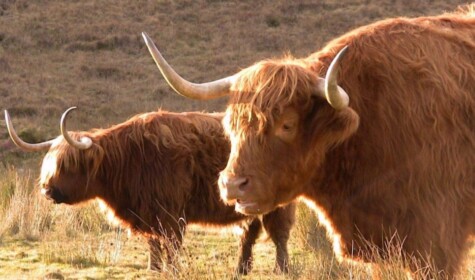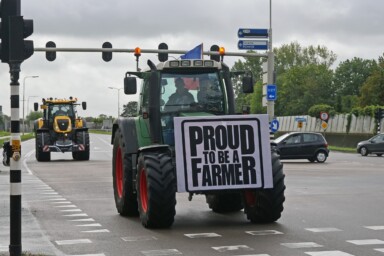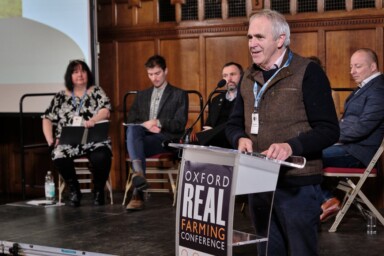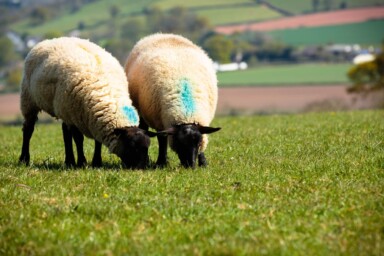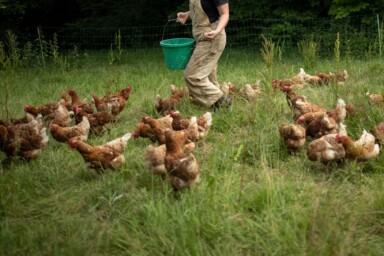As part of our exploration of Brexit and future agricultural policy, our policy assistant Robert Barbour, whose family runs a mixed livestock farm in Scotland, gives his perspective on what the future holds for Scottish agricultural policy post-Brexit.
For thousands of years, farming has played a fundamental role in shaping Scotland’s countryside. Today, around three-quarters of the country is under some form of agricultural production, and the sector continues to be of huge importance for environmental, social and economic reasons.
Some 85% of Scotland’s agricultural land is designated as ‘Less Favoured Area’, an EU classification which reflects the harsh environmental conditions that constrain productivity across much of the country. Due to poor soils, mountainous terrain and a cold wet climate, growing crops is generally not possible in these areas, meaning that extensive livestock production, particularly of sheep but also of beef cattle, is the predominant agricultural activity. Scotland produces exceptional quality beef and lamb, but lower prices and the cessation of headage support payments has resulted in the loss of large numbers of stock from hill ground over recent years, especially in the north west.
Other forms of livestock production are mostly limited to the lowlands, where there is the capacity to produce animal feed crops alongside better grass growing conditions. As with the rest of the UK, low milk prices have led to the loss of many dairy farms, but the industry is still important in areas which can grow grass for much of the year, like Ayrshire. Pig farming has also declined somewhat in recent years, but the poultry sector is enjoying considerable growth, largely as a response to the increased demand for chicken meat.
Unlike in Wales and Northern Ireland, crop production is of significant importance, constituting around 10% of Scotland’s agricultural area, largely in the south and east. Barley is particularly prominent, with around half going for animal feed and a third being used for malting, making it a key crop for Scotland’s £3.8 billion whisky industry. Scotland also produces most of the UK’s seed potato crop, while soft fruit production is particularly prominent in Tayside.
The wide variety of farming practices is reflected in the diversity of landholdings. Scottish farms are considerably larger on average than in the rest of the UK, mostly because the poor quality of much of the land necessitates extensive areas for grazing, although Scotland’s highly concentrated pattern of land ownership is also a factor. However, where crofting (a system of land tenure and small-scale agricultural production unique to the Highlands and Islands) is prevalent, landholdings are typically much smaller, the average croft being 5 hectares in size. Incomes tend to be low, but crofting is an immensely important part of the social fabric of the north and west, with crofts constituting up to 65% of households in some areas.
Across Scotland as a whole, the percentage of the population employed in agriculture is considerably lower than this – around 2.6% – but that figure rises to 8% in rural areas, and around 10% of all Scottish jobs are in some way reliant upon farming. It is clear, therefore, that agriculture is an important component of Scotland’s economy. However, profitability is an increasingly major problem. According to food justice charity Nourish Scotland, 45% of Scottish farmers didn’t make enough money to pay themselves the agricultural minimum wage in 2017, and if it wasn’t for support payments, the average farm would lose almost £15,000 a year. This is a problem across the UK, but it is particularly acute in Scotland and Wales, largely because of the greater proportion of farms on marginal land. As a result, support payments have become more or less essential for many producers.
Farming is a devolved matter, meaning Scotland has its own system of agricultural support, funded through the EU Common Agricultural Policy. A large portion of the £500 million annual budget is delivered via the Basic Payment Scheme (BPS), an area-based income support with three payment rates tiered according to the quality of land (the better the land, the higher the rate). Because such a high percentage of the country is poor quality land (therefore qualifying for the lowest payment rate) Scotland has historically only been paid 45% of the average EU area rate, a shortfall which was supposedly addressed by the EU in 2014 when it granted an extra £190 million of ‘convergence’ cash to the UK government to recompense Scottish hill farmers. Most of this money was withheld by Westminster, however, due the continued use of the old allocation system, and has only recently been promised to Scotland in full after years of bitter argument. The receipt of this extra funding has been welcomed (although there are concerns that it won’t be allocated in its entirety to the intended recipients) but tensions between Holyrood and Westminster remain high, particularly over the possible curtailment of devolved powers due to Brexit.
Dwarfing these concerns, however, are the funding implications of Brexit. One major unknown is what the Scottish system of agricultural support will look like post-Brexit. A five-year transition period has been proposed by the Scottish government, but beyond suggestions of a move towards rewarding the delivery of public goods, there has not yet been any concrete legislation set out, in contrast to the rest of the UK. The Scottish Government has claimed that it cannot create more detailed plans until it knows how much funding it is going to receive from Westminster (yet another Brexit sticking point), but while this is a valid criticism, the failure to provide any sort of roadmap for Scottish agriculture going forward has only added to the existing uncertainty.
Brexit also poses a major threat to Scottish agriculture through the introduction of tariffs. For the red meat sector, this could be catastrophic, with a no-deal scenario possibly resulting in EU tariffs as high as 50%. Sheep farmers would be particularly vulnerable to such an increase – a third of all British lamb is currently sold into Europe, and the loss of free entry to this market would almost certainly lead to a crash in domestic prices. Beef production, on the other hand, may face more of a threat from free trade deals struck with major beef exporting countries like Brazil, whose lower production costs could undercut Scottish farmers. For other agricultural sectors, worries over the impacts of tariffs are generally less severe, though major issues still exist. For example, Scottish seed potato exports to the EU are currently worth over £6 million a year, but this market would be lost in a no-deal Brexit.
Predicting the future of Scottish agriculture amidst all of this uncertainty is nigh on impossible, but whatever the result of Brexit, it is fairly certain that there will be more of a focus on environmental impact. Chief amongst the reasons for this is the urgent need to reduce GHG emissions, in which agriculture (the source of around a quarter of Scotland’s total emissions) will have to play a major role. How exactly this should be achieved is more contentious: actions like peatland restoration are universally supported, but some have argued that massively reducing the numbers of sheep and cattle is more important, with grazing lands instead being afforested for carbon sequestration. This land-sparing, or rewilding, approach has also been promoted as a means of improving biodiversity and providing natural flood management, whilst at the same time enabling alternative and perhaps more lucrative income streams for land managers in the form of forestry and ecotourism.
Unsurprisingly, many in the farming community disagree vehemently with this approach, pointing to the environmental benefits which grazing livestock provide and the likely negative impacts on already fragile rural communities. Certainly, the narrative around the unsustainability of ruminant livestock is not as straightforward as is often made out: achieving a net zero contribution from Scottish agriculture does not actually require the massive cuts in livestock numbers some prescribe, and maintaining grazing livestock is crucial for some of Scotland’s most important habitats and species, though overgrazing remains a problem. Furthermore, focusing purely on the uplands runs the risk of ignoring the very significant environmental problems associated with lowland agriculture, such as major declines in biodiversity and nitrogen pollution.
Perhaps a more constructive approach is to improve the sustainability of all farming systems, and to do this by adopting a public money for public goods framework. There are signs that this is the route which the Scottish government will follow, but debate continues around the extent to which this should be the focus, versus emphasising productivity. One potential policy vehicle for creating a more sustainable, just and resilient food system may be the Scottish Government’s proposed Good Food Nation Bill, which is set to be introduced to Parliament this term. Its aim is to establish a much more holistic approach to governing all aspects of the food system, from improving the sustainability and profitability of farms, through to ensuring universal access to healthy food. Some good work has already been achieved in certain areas (for example the ambitious food waste strategy) and the scope of the Government’s plans are ground-breaking. However, concerns have been raised that the necessary statutory oversight might not materialise, and that instead of one cross-sectoral bill, a more piece-meal programme will be followed. In short, the jury is out as to whether the plans will live up to their promise.
It is clear that Scottish agriculture is at a critical juncture – other issues not even mentioned above such as the loss of small abattoirs, an ageing workforce and demands for land reform are all potentially disruptive in their own right. This does, however, provide an opportunity to forge a more sustainable and equitable farming system going forwards. Achieving this will be difficult, requiring a major shift in mindset, but the rewards could be enormous.
You can read a Scottish farmer’s perspective on Brexit, here.
